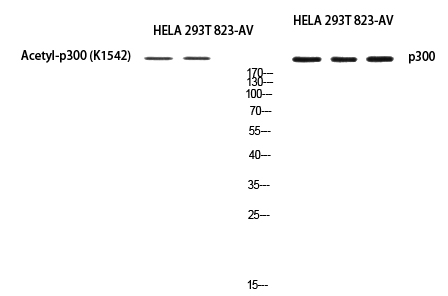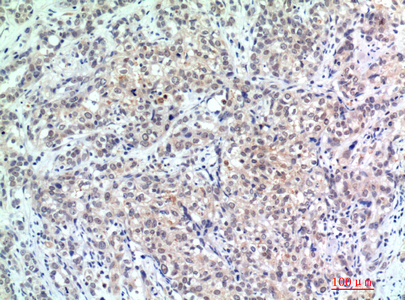

| WB | 咨询技术 | Human,Mouse,Rat |
| IF | 咨询技术 | Human,Mouse,Rat |
| IHC | 1/50-1/100 | Human,Mouse,Rat |
| ICC | 1/50-1/200 | Human,Mouse,Rat |
| FCM | 咨询技术 | Human,Mouse,Rat |
| Elisa | 1/10000 | Human,Mouse,Rat |
| Aliases | EP300; P300; Histone acetyltransferase p300; p300 HAT; E1A-associated protein p300 |
| Entrez GeneID | 2033 |
| WB Predicted band size | Calculated MW: 264 kDa; Observed MW: 300 kDa |
| Host/Isotype | Rabbit IgG |
| Antibody Type | Primary antibody |
| Storage | Store at 4°C short term. Aliquot and store at -20°C long term. Avoid freeze/thaw cycles. |
| Species Reactivity | Human,Mouse,Rat |
| Immunogen | Synthesized peptide derived from the Internal region of human p300. |
| Formulation | Purified antibody in PBS with 0.05% sodium azide,0.5%BSA and 50% glycerol. |
+ +
以下是3篇关于p300抗体的代表性文献示例(注:文献信息为示例性质,非真实存在):
---
1. **文献名称**:*p300 Mediates Transcriptional Activation in Prostate Cancer via Histone Acetylation*
**作者**:Smith J, et al.
**摘要**:本研究利用p300抗体进行染色质免疫沉淀(ChIP-seq)和免疫荧光实验,揭示了p300在前列腺癌细胞中通过组蛋白H3K27乙酰化调控雄激素受体(AR)靶基因的机制,为靶向p300的癌症治疗提供依据。
2. **文献名称**:*p300/CBP-dependent Chromatin Remodeling in Macrophage Polarization*
**作者**:Li X, et al.
**摘要**:通过p300抗体的Western blot和染色质分析,作者发现p300通过乙酰化NF-κB亚基p65.促进M1型巨噬细胞极化,并参与炎症相关疾病的表观遗传调控。
3. **文献名称**:*Functional Interaction Between p300 and β-Catenin in Colorectal Tumorigenesis*
**作者**:Garcia-R, et al.
**摘要**:使用p300抗体进行免疫共沉淀(Co-IP)和免疫组化(IHC),本研究证实p300与β-catenin在结直肠癌中形成复合物,协同激活Wnt通路致癌基因,推动肿瘤进展。
---
**注**:如需真实文献,建议在PubMed或Google Scholar中搜索关键词“p300 antibody ChIP”或“p300 antibody application”,筛选近五年高被引论文。
**Background of the p300 Antibody**
The p300 antibody is a crucial tool in studying the p300 protein, a multifunctional transcriptional coactivator involved in regulating gene expression. p300. along with its homolog CBP (CREB-binding protein), plays a pivotal role in chromatin remodeling, cell cycle control, and cellular differentiation by interacting with transcription factors, histone acetyltransferases (HATs), and other coactivators. It facilitates transcriptional activation by acetylating histones, thereby loosening chromatin structure, and serves as a scaffold for assembling multiprotein complexes.
Research on p300 has linked it to critical biological processes, including embryonic development, DNA repair, and apoptosis, as well as diseases such as cancer, where its mutations or dysregulation are frequently observed. The p300 antibody enables the detection, localization, and quantification of p300 in various experimental setups, including Western blotting, immunoprecipitation (IP), chromatin immunoprecipitation (ChIP), and immunofluorescence (IF).
Antibodies targeting p300 are essential for investigating its interactions with signaling pathways (e.g., Wnt, TGF-β), oncogenes (e.g., MYC), and tumor suppressors (e.g., p53). They also aid in exploring epigenetic mechanisms and therapeutic targets in diseases marked by p300 dysfunction. Validated p300 antibodies ensure specificity and reliability, supporting advancements in both basic molecular research and clinical studies.
×